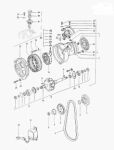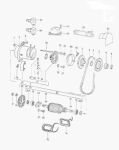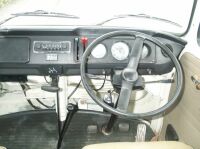Electrical aspects to check when buying
a Bay-Window (68-79) Volkswagen
van!
Click any image to enlarge
The electrical system on the Bay-Window Type 2 is very simple compared to
a modern vehicle with the only likely problems being damage, overloading and aging.
The battery (12 volt) is situated in the engine bay, on the right hand side. Check that it is the
correct size - at least 45 amp/hour. Many people will swap a good battery for one on its last legs, when it comes to selling,
so check as a replacement battery costs around 40 pound. Check that the battery has the round, post terminals
as for some reason if a battery has been swapped it is usually for a Ford battery which has different terminals.
 Depending on the engine fitted and the year of manufacture either a dynamo or an alternator could be fitted. All T4 engined
vans had an alternator fitted as standard and all vans had an alternator fitted as standard
from 1974 onwards. The output of the dynamo is dependant on engine speed and at tick over engine speeds,
the dynamo barely gives enough output to keep the battery charged. The dynamo will only give 30 amps maximum. Start using accessories, lights and windscreen wipers etc. in
a traffic jam and you will soon have a flat battery. The generator light on the dash, should go out when the engine is started but on Dynamo equipped
models the light has a tendency to glow dimly when any load such as lights is placed on the system. The generator light should go out
when the engine speed moves above idle. Dynamos are quite easy to overhaul but difficult to remove without removing the engine first but the carbon
brushes can be removed with the dynamo in place. Alternator powered systems do not suffer from lack
of charging power as the alternator output is independent of engine speed. 1600cc models equipped
with a dynamo can be upgraded to an alternator system but it is quite expensive as the kit contains the alternator, pedestal which it sits on and
new locating strap. If you plan on fitting a high powered stereo system you really have no choice
but to change to an alternator if you want to avoid a flat battery in the morning. Cost of an alternator upgrade kit is £145 from Just Kampers
Depending on the engine fitted and the year of manufacture either a dynamo or an alternator could be fitted. All T4 engined
vans had an alternator fitted as standard and all vans had an alternator fitted as standard
from 1974 onwards. The output of the dynamo is dependant on engine speed and at tick over engine speeds,
the dynamo barely gives enough output to keep the battery charged. The dynamo will only give 30 amps maximum. Start using accessories, lights and windscreen wipers etc. in
a traffic jam and you will soon have a flat battery. The generator light on the dash, should go out when the engine is started but on Dynamo equipped
models the light has a tendency to glow dimly when any load such as lights is placed on the system. The generator light should go out
when the engine speed moves above idle. Dynamos are quite easy to overhaul but difficult to remove without removing the engine first but the carbon
brushes can be removed with the dynamo in place. Alternator powered systems do not suffer from lack
of charging power as the alternator output is independent of engine speed. 1600cc models equipped
with a dynamo can be upgraded to an alternator system but it is quite expensive as the kit contains the alternator, pedestal which it sits on and
new locating strap. If you plan on fitting a high powered stereo system you really have no choice
but to change to an alternator if you want to avoid a flat battery in the morning. Cost of an alternator upgrade kit is £145 from Just Kampers
 Check the condition of the wiring, especially in the engine bay. Previous owners will probably
have added an up-rated radio system, cigarette lighter socket or extra lights which
place a strain on the system that it was not designed to cope with. Check the quality of the
connectors used. Ideally the connection,
will be soldered and covered with heat shrink but typically you will find "Scotch" and "Lucas"
connectors or worse, (but usual) wires just twisted together and covered with insulation tape,
which is a major fire hazard. Again, as with all things on the Type 2, you are looking for an impression,
that the vehicle has been looked after correctly and what do wires twisted together tell you?
Check the condition of the wiring, especially in the engine bay. Previous owners will probably
have added an up-rated radio system, cigarette lighter socket or extra lights which
place a strain on the system that it was not designed to cope with. Check the quality of the
connectors used. Ideally the connection,
will be soldered and covered with heat shrink but typically you will find "Scotch" and "Lucas"
connectors or worse, (but usual) wires just twisted together and covered with insulation tape,
which is a major fire hazard. Again, as with all things on the Type 2, you are looking for an impression,
that the vehicle has been looked after correctly and what do wires twisted together tell you?
An accessory that is beneficial to camper conversions in particular is a second battery also known as a
leisure battery and a split charging system. The second battery is used to power all addition
accessories such as interior lights, cool box or fridge etc. The benefit of this system is that you can run the second battery down flat when camping and the van will
still start using the original battery as they are separate systems. A relay controls the
charging of the second battery, which receives a charge from the original battery but when the
engine is stopped, the contact in the relay is opened, stopping current passing from the original
battery to the leisure system. If you want a second battery system, a 70amp/hour battery
costs around £50 and a relay about £5 if you build yourself or £20 from a
supplier already built. A 70 amp/ hour battery means that you can run a 3.5 amp accessory for 20 hours
before the battery is flat. If adding a leisure battery, add up all the accessories you have and
typically how long you will use them before deciding what size battery to buy.
Test all the electrical appliances - wipers, lights and horn to make sure they work. The wipers typically sweep across the screen very slowly. If the lights are dull, then they are not receiving the full voltage.
A high volt drop between the lights and the battery is usually down to a dirty connection
giving a high resistance. All this requires to remedy, is each connection taking apart and cleaning. If you get
the chance to drive the van at night and the lights are dull but the bulb looks bright, check that
the headlight reflective bowl is not rusty, lowering the efficiency plus this is an MOT failure. Replacement is
easy and cheap.
When starting the engine, the starter should spin quickly with a smooth noise. If the starter does not
turn when the ignition key is turned, check that the solenoid on the starters side is clicking.
If the solenoid clicks but the starter does not turn then the starter is jamming and is worn. To get it going, try tapping
the starter when the ignition key is turned with a hammer, which may jolt the starter into moving. This is a get you
home technique only but who would want to get under there van every morning anyway? A recondition starter motor
costs around £50.
 The dash electrics are very simple as standard. VW only supplied a speedometer, fuel gauge, oil warning light,
generator warning light and a high beam and lights on, light. A time clock was an optional and rare extra.
The petrol tank float sender unit is prone to sticking in one position, usually on empty after the tank has been run very low.
Check that the gauge moves up or down when travelling up or down a hill. With the fuels consumption of most vans, you don't need
a hill to see the fuel gauge move. Replacement of the sender unit requires the engine and the fuel tank
to be removed - expensive.
The dash electrics are very simple as standard. VW only supplied a speedometer, fuel gauge, oil warning light,
generator warning light and a high beam and lights on, light. A time clock was an optional and rare extra.
The petrol tank float sender unit is prone to sticking in one position, usually on empty after the tank has been run very low.
Check that the gauge moves up or down when travelling up or down a hill. With the fuels consumption of most vans, you don't need
a hill to see the fuel gauge move. Replacement of the sender unit requires the engine and the fuel tank
to be removed - expensive.
Most fires in a Type 2 start in the engine bay due to the amount of oil and fuel around. Check the condition
of the wiring. The 12V positive terminal on the coil powers the distributor, choke heating element and the anti-run on solenoid on the carburetor.
These wires should be routed carefully were they cannot be caught and the terminals should be tight but are normally not. Changing, the
terminals and soldering the joints is only a 30 minute job but worth while.
Home
 Depending on the engine fitted and the year of manufacture either a dynamo or an alternator could be fitted. All T4 engined
vans had an alternator fitted as standard and all vans had an alternator fitted as standard
from 1974 onwards. The output of the dynamo is dependant on engine speed and at tick over engine speeds,
the dynamo barely gives enough output to keep the battery charged. The dynamo will only give 30 amps maximum. Start using accessories, lights and windscreen wipers etc. in
a traffic jam and you will soon have a flat battery. The generator light on the dash, should go out when the engine is started but on Dynamo equipped
models the light has a tendency to glow dimly when any load such as lights is placed on the system. The generator light should go out
when the engine speed moves above idle. Dynamos are quite easy to overhaul but difficult to remove without removing the engine first but the carbon
brushes can be removed with the dynamo in place. Alternator powered systems do not suffer from lack
of charging power as the alternator output is independent of engine speed. 1600cc models equipped
with a dynamo can be upgraded to an alternator system but it is quite expensive as the kit contains the alternator, pedestal which it sits on and
new locating strap. If you plan on fitting a high powered stereo system you really have no choice
but to change to an alternator if you want to avoid a flat battery in the morning. Cost of an alternator upgrade kit is £145 from Just Kampers
Depending on the engine fitted and the year of manufacture either a dynamo or an alternator could be fitted. All T4 engined
vans had an alternator fitted as standard and all vans had an alternator fitted as standard
from 1974 onwards. The output of the dynamo is dependant on engine speed and at tick over engine speeds,
the dynamo barely gives enough output to keep the battery charged. The dynamo will only give 30 amps maximum. Start using accessories, lights and windscreen wipers etc. in
a traffic jam and you will soon have a flat battery. The generator light on the dash, should go out when the engine is started but on Dynamo equipped
models the light has a tendency to glow dimly when any load such as lights is placed on the system. The generator light should go out
when the engine speed moves above idle. Dynamos are quite easy to overhaul but difficult to remove without removing the engine first but the carbon
brushes can be removed with the dynamo in place. Alternator powered systems do not suffer from lack
of charging power as the alternator output is independent of engine speed. 1600cc models equipped
with a dynamo can be upgraded to an alternator system but it is quite expensive as the kit contains the alternator, pedestal which it sits on and
new locating strap. If you plan on fitting a high powered stereo system you really have no choice
but to change to an alternator if you want to avoid a flat battery in the morning. Cost of an alternator upgrade kit is £145 from Just Kampers  Check the condition of the wiring, especially in the engine bay. Previous owners will probably
have added an up-rated radio system, cigarette lighter socket or extra lights which
place a strain on the system that it was not designed to cope with. Check the quality of the
connectors used. Ideally the connection,
will be soldered and covered with heat shrink but typically you will find "Scotch" and "Lucas"
connectors or worse, (but usual) wires just twisted together and covered with insulation tape,
which is a major fire hazard. Again, as with all things on the Type 2, you are looking for an impression,
that the vehicle has been looked after correctly and what do wires twisted together tell you?
Check the condition of the wiring, especially in the engine bay. Previous owners will probably
have added an up-rated radio system, cigarette lighter socket or extra lights which
place a strain on the system that it was not designed to cope with. Check the quality of the
connectors used. Ideally the connection,
will be soldered and covered with heat shrink but typically you will find "Scotch" and "Lucas"
connectors or worse, (but usual) wires just twisted together and covered with insulation tape,
which is a major fire hazard. Again, as with all things on the Type 2, you are looking for an impression,
that the vehicle has been looked after correctly and what do wires twisted together tell you?
 The dash electrics are very simple as standard. VW only supplied a speedometer, fuel gauge, oil warning light,
generator warning light and a high beam and lights on, light. A time clock was an optional and rare extra.
The petrol tank float sender unit is prone to sticking in one position, usually on empty after the tank has been run very low.
Check that the gauge moves up or down when travelling up or down a hill. With the fuels consumption of most vans, you don't need
a hill to see the fuel gauge move. Replacement of the sender unit requires the engine and the fuel tank
to be removed - expensive.
The dash electrics are very simple as standard. VW only supplied a speedometer, fuel gauge, oil warning light,
generator warning light and a high beam and lights on, light. A time clock was an optional and rare extra.
The petrol tank float sender unit is prone to sticking in one position, usually on empty after the tank has been run very low.
Check that the gauge moves up or down when travelling up or down a hill. With the fuels consumption of most vans, you don't need
a hill to see the fuel gauge move. Replacement of the sender unit requires the engine and the fuel tank
to be removed - expensive.